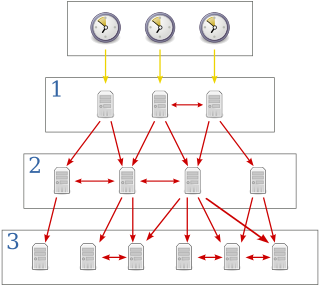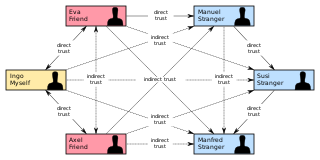
Electronic mail is a method of transmitting and receiving messages using electronic devices. It was conceived in the late–20th century as the digital version of, or counterpart to, mail. Email is a ubiquitous and very widely used communication medium; in current use, an email address is often treated as a basic and necessary part of many processes in business, commerce, government, education, entertainment, and other spheres of daily life in most countries.

The Hypertext Transfer Protocol (HTTP) is an application layer protocol in the Internet protocol suite model for distributed, collaborative, hypermedia information systems. HTTP is the foundation of data communication for the World Wide Web, where hypertext documents include hyperlinks to other resources that the user can easily access, for example by a mouse click or by tapping the screen in a web browser.
Multiprotocol Label Switching (MPLS) is a routing technique in telecommunications networks that directs data from one node to the next based on labels rather than network addresses. Whereas network addresses identify endpoints, the labels identify established paths between endpoints. MPLS can encapsulate packets of various network protocols, hence the multiprotocol component of the name. MPLS supports a range of access technologies, including T1/E1, ATM, Frame Relay, and DSL.
In computing, Internet Protocol Security (IPsec) is a secure network protocol suite that authenticates and encrypts packets of data to provide secure encrypted communication between two computers over an Internet Protocol network. It is used in virtual private networks (VPNs).

An email client, email reader or, more formally, message user agent (MUA) or mail user agent is a computer program used to access and manage a user's email.

The Network Time Protocol (NTP) is a networking protocol for clock synchronization between computer systems over packet-switched, variable-latency data networks. In operation since before 1985, NTP is one of the oldest Internet protocols in current use. NTP was designed by David L. Mills of the University of Delaware.
The Internet Architecture Board (IAB) is "a committee of the Internet Engineering Task Force (IETF) and an advisory body of the Internet Society (ISOC). Its responsibilities include architectural oversight of IETF activities, Internet Standards Process oversight and appeal, and the appointment of the Request for Comments (RFC) Editor. The IAB is also responsible for the management of the IETF protocol parameter registries."
In cryptography, X.509 is an International Telecommunication Union (ITU) standard defining the format of public key certificates. X.509 certificates are used in many Internet protocols, including TLS/SSL, which is the basis for HTTPS, the secure protocol for browsing the web. They are also used in offline applications, like electronic signatures.

Phishing is a form of social engineering and scam where attackers deceive people into revealing sensitive information or installing malware such as ransomware. Phishing attacks have become increasingly sophisticated and often transparently mirror the site being targeted, allowing the attacker to observe everything while the victim is navigating the site, and transverse any additional security boundaries with the victim. As of 2020, it is the most common type of cybercrime, with the FBI's Internet Crime Complaint Center reporting more incidents of phishing than any other type of computer crime.

In psychology and sociology, a trust metric is a measurement or metric of the degree to which one social actor trusts another social actor. Trust metrics may be abstracted in a manner that can be implemented on computers, making them of interest for the study and engineering of virtual communities, such as Friendster and LiveJournal.
Reputation management, originally a public relations term, refers to the influencing, controlling, enhancing, or concealing of an individual's or group's reputation. The growth of the internet and social media led to growth of reputation management companies, with search results as a core part of a client's reputation. Online reputation management, sometimes abbreviated as ORM, focuses on the management of product and service search engine results.
Email authentication, or validation, is a collection of techniques aimed at providing verifiable information about the origin of email messages by validating the domain ownership of any message transfer agents (MTA) who participated in transferring and possibly modifying a message.
Yhprum's law is the opposite of Murphy's law. The simple formula of Yhprum's law is: "Everything that can work, will work." "Yhprum" is "Murphy" spelled in reverse.
A Sybil attack is a type of attack on a computer network service in which an attacker subverts the service's reputation system by creating a large number of pseudonymous identities and uses them to gain a disproportionately large influence. It is named after the subject of the book Sybil, a case study of a woman diagnosed with dissociative identity disorder. The name was suggested in or before 2002 by Brian Zill at Microsoft Research. The term pseudospoofing had previously been coined by L. Detweiler on the Cypherpunks mailing list and used in the literature on peer-to-peer systems for the same class of attacks prior to 2002, but this term did not gain as much influence as "Sybil attack".

A feedback loop (FBL), sometimes called a complaint feedback loop, is an inter-organizational form of feedback by which a mailbox provider (MP) forwards the complaints originating from their users to the sender's organizations. MPs can receive users' complaints by placing report spam buttons on their webmail pages, or in their email client, or via help desks. The message sender's organization, often an email service provider, has to come to an agreement with each MP from which they want to collect users' complaints.
Online participation is used to describe the interaction between users and online communities on the web. Online communities often involve members to provide content to the website and/or contribute in some way. Examples of such include wikis, blogs, online multiplayer games, and other types of social platforms. Online participation is currently a heavily researched field. It provides insight into fields such as web design, online marketing, crowdsourcing, and many areas of psychology. Some subcategories that fall under online participation are: commitment to online communities, coordination & interaction, and member recruitment.
HTTP Strict Transport Security (HSTS) is a policy mechanism that helps to protect websites against man-in-the-middle attacks such as protocol downgrade attacks and cookie hijacking. It allows web servers to declare that web browsers should automatically interact with it using only HTTPS connections, which provide Transport Layer Security (TLS/SSL), unlike the insecure HTTP used alone. HSTS is an IETF standards track protocol and is specified in RFC 6797.
DNS-based Authentication of Named Entities (DANE) is an Internet security protocol to allow X.509 digital certificates, commonly used for Transport Layer Security (TLS), to be bound to domain names using Domain Name System Security Extensions (DNSSEC).
Q&A software is online software that attempts to answer questions asked by users. Q&A software is frequently integrated by large and specialist corporations and tends to be implemented as a community that allows users in similar fields to discuss questions and provide answers to common and specialist questions.
Proof of personhood (PoP) is a means of resisting malicious attacks on peer to peer networks, particularly, attacks that utilize multiple fake identities, otherwise known as a Sybil attack. Decentralized online platforms are particularly vulnerable to such attacks by their very nature, as notionally democratic and responsive to large voting blocks. In PoP, each unique human participant obtains one equal unit of voting power, and any associated rewards.






